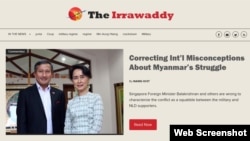As Myanmar's opposition forces and ethnic armed groups step up their fight against the ruling junta, the country's media outlets are working to cover the action.
Since October, a coalition of armed ethnic groups in northern Shan state have captured dozens of townships and hundreds of junta-held military posts.
Observers say the offensive is the biggest threat to the junta since the military seized power on Feb. 1, 2021, jailing democratically elected leaders along with dozens of journalists and opposition figures.
With authorities revoking the licenses of around a dozen news outlets and mass arrests of media workers, many journalists moved their teams into exile. But despite the safety risks, they continue to report.
Among the now banned media outlets is The Irrawaddy, which had its license revoked in October 2022.
Its managing editor, Kyaw Zwa Moe, told VOA that covering the offensive is difficult.
"We couldn't send our reporters out there, but we have a lot of local sources which are reliable, and we have also interviewed spokespersons of most of resistance organizations quite often," said Kyaw Zwa Moe via email. "But one of the main challenges is to verify all information we've gathered."
There are moments when The Irrawaddy can get its own people on the ground, like when the opposition forces launched attacks on military posts in Kayah state in November.
But, said Kyaw Zwa Moe, it is still challenging to get the full picture.
"To some extent, spokespersons of those resistance forces, the Brotherhood Alliance, are more willing to talk to media. But I don't think they would say all information to us as they say there are security concerns for them because of the ongoing war," Kyaw Zwa Moe said.
Aye Chan Naing, the founder and chief editor of the Democratic Voice of Burma, or DVB, says gaining access to the conflict is "pretty problematic."
The DVB is also banned by the junta and its team now operates in neighboring countries.
For security reasons, a lot of ethnic groups and the People's Defense Forces, or PDF, don't want the responsibility of having media nearby, said Aye Chan Naing.
"Secrecy is very important. It's understandable for them. The military operation, the target, they want to keep it quiet or secret," he told VOA. "We have to rely on press releases and announcements. To verify independently, it's really hard."
The media outlet has local people to act as freelancers in the area, but, said Aye Chan Naing, "We don't have like someone from DVB for example, right on the ground. No one's embedded. So that's a big part of the problem to get an independent story."
To report legally in Myanmar under junta rule, media outlets have to register with the military government.
But as part of the accreditation process, journalists must provide personal details — a step that deters many who fear they could be more easily targeted for arrest.
Journalists arrested, killed
Since the coup, 176 journalists have been arrested, with as many as 50 still in custody, according to the International Federation of Journalists. At least four journalists have been killed since the military takeover, the media organization reports.
Media outlets covering Myanmar had to train reporters on how to work safely undercover, evading military checkpoints and raids.
On the opposition side, the forces are also cautious of reporters.
"Journalists are not welcome in the conflict area from both sides. It's ongoing military operation. They don't want to [let] information out for security reasons," Toe Zaw Latt, a journalist at the Mizzima media outlet, told VOA.
Toe Zaw Latt, who like so many now works outside of Myanmar, said that even following a successful operation by the ethnic armed groups, little information is provided to media.
"It is confusing who is in charge. We tried to get information from the resistance after they seized a town. We like to know what kind of administration and most of them refused to comment due to security concern," he said. "We are heavily reliant on our [citizen journalists] and other partners we have."
Unstable connection makes communications difficult
Another challenge is an internet connection, which is often unstable in rural areas. The junta also have imposed internet blackouts since the coup.
Toe Zaw Latt said it's difficult to communicate with reporters on the ground.
"Their communication is very controlled. The connection is very crap. It's not that easy. Whenever there is a military operation [on] another channel, they cut all the communication channels," he said.
"I think it's really important for our own sake. We have to be constant and deep down on the stories," said Aye Chan Naing.
He remained optimistic that if the media can explain the importance of coverage to the opposition forces, "they will see the benefit of it."
"But once we go in," he said, "we have to be independent because sometimes they want to censor the content that journalists on the ground report back."
An additional concern is how to keep their reporters safe in a conflict zone. Embedding with opposition forces such as the PDF brings access — but also risks, said Aye Chan Naing.
The PDF "always face random airstrikes, the military ambushes. So, the journalists are not exceptional. That's a huge risk," he said.
Since the coup, Myanmar's press freedom ranking has declined dramatically. It now ranks among the 10 worst countries for media globally on the world press freedom index and is one of the biggest jailers of journalists.









